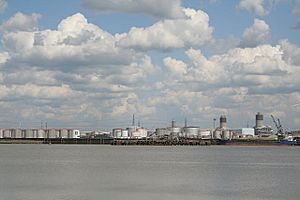Dagenham Dock facts for kids
Quick facts for kids Dagenham Dock |
|
|---|---|
 Dagenham Dock viewed from the River Thames |
|
| Population | 7,855 (Rylands Estate & Dagenham Dock MSOA, E02000021, 2011 Census) |
| • Charing Cross | 11.6 mi (18.7 km) W |
| London borough | |
| Ceremonial county | Greater London |
| Region | |
| Country | England |
| Sovereign state | United Kingdom |
| Post town | DAGENHAM |
| Postcode district | RM9 |
| Dialling code | 020 |
| Police | Metropolitan |
| Fire | London |
| Ambulance | London |
| EU Parliament | London |
| UK Parliament |
|
| London Assembly | |
Dagenham Dock is an industrial area in London, England. It's part of the London Borough of Barking and Dagenham. You can find it south of Dagenham, right next to the River Thames.
This area used to be a big port for coal. Today, it still has a small terminal for unloading coal. Dagenham Dock is also home to many businesses that use the river. One large site has about 200 tanks for storing different liquids. These include petrol, jet fuel, and even biofuels.
History of Dagenham Dock
The area where Dagenham Dock now stands was once a marshy, flooded place. This happened because a sea wall broke in 1707. It kept flooding many times in the 1700s.
In 1865, a man named Sir John Rennie tried to build a jetty and a railway line there. But his company didn't succeed. Later, in 1887, Samuel Williams bought the land. He built Dagenham Dock over an area of about 30 acres (120,000 m2).
In the early 1900s, a famous warship called HMS Thunderer was completed here. It was the last big warship built on the River Thames. The jetty where it was finished is still known as the Thunderer Jetty today.
New Wholesale Market Plans
Between 1992 and 1995, a large power station called Barking Reach Power Station was built in Dagenham Dock. It was one of the first big power stations in London for many years. It stopped operating in 2018.
In 2018, the City of London Corporation bought the power station site. The City of London Corporation is a very old organization. It is in charge of providing special wholesale markets for London. Wholesale markets are places where businesses buy large amounts of goods, like fish, meat, or vegetables, directly from suppliers.
The Corporation wants to move three of London's main wholesale markets to one new location. These markets are:
- Billingsgate Fish Market (for fish)
- Smithfield Meat Market (for meat)
- New Spitalfields Market (for fruits and vegetables)
They looked at several places for this new market. In April 2019, they chose the old Barking Reach Power Station site in Dagenham Dock. In March 2021, the local council, Barking and Dagenham Council, approved the plans. The new market is expected to open around 2027 or 2028.
Geography of Dagenham Dock
Dagenham Dock is located in an important development area called London Riverside. This area is part of the larger Thames Gateway zone. It also includes the London Sustainable Industries Park. This park is a special area for businesses that focus on being environmentally friendly.
There are plans to improve the Dagenham Dock railway station. This will help the area grow. It could also bring new transport links like the Docklands Light Railway and East London Transit.
Here's what's around Dagenham Dock:
- To the east: Hornchurch Marshes (a natural marshland area)
- To the west: Barking Riverside (a new housing and development area)
- To the south: The River Thames
- To the north: The Merrielands Retail Park and the Becontree and Rylands housing estates
See also


